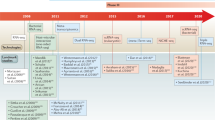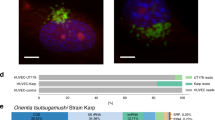Abstract
The ability to simultaneously characterize the bacterial and host expression programs during infection would facilitate a comprehensive understanding of pathogen–host interactions. Although RNA sequencing (RNA-seq) has greatly advanced our ability to study the transcriptomes of prokaryotes and eukaryotes separately, limitations in existing protocols for the generation and analysis of RNA-seq data have hindered simultaneous profiling of host and bacterial pathogen transcripts from the same sample. Here we provide a detailed protocol for simultaneous analysis of host and bacterial transcripts by RNA-seq. Importantly, this protocol details the steps required for efficient host and bacteria lysis, barcoding of samples, technical advances in sample preparation for low-yield sample inputs and a computational pipeline for analysis of both mammalian and microbial reads from mixed host–pathogen RNA-seq data. Sample preparation takes 3 d from cultured cells to pooled libraries. Data analysis takes an additional day. Compared with previous methods, the protocol detailed here provides a sensitive, facile and generalizable approach that is suitable for large-scale studies and will enable the field to obtain in-depth analysis of host–pathogen interactions in infection models.
This is a preview of subscription content, access via your institution
Access options
Subscribe to this journal
Receive 12 print issues and online access
$259.00 per year
only $21.58 per issue
Buy this article
- Purchase on Springer Link
- Instant access to full article PDF
Prices may be subject to local taxes which are calculated during checkout



Similar content being viewed by others
References
Galan, J.E. & Wolf-Watz, H. Protein delivery into eukaryotic cells by type III secretion machines. Nature 444, 567–573 (2006).
Medzhitov, R. TLR-mediated innate immune recognition. Semin. Immunol. 19, 1–2 (2007).
Eriksson, S., Lucchini, S., Thompson, A., Rhen, M. & Hinton, J.C. Unravelling the biology of macrophage infection by gene expression profiling of intracellular Salmonella enterica. Mol. Microbiol. 47, 103–118 (2003).
Berry, M.P. et al. An interferon-inducible neutrophil-driven blood transcriptional signature in human tuberculosis. Nature 466, 973–977 (2010).
Westermann, A.J., Gorski, S.A. & Vogel, J. Dual RNA-seq of pathogen and host. Nat. Rev. Microbiol. 10, 618–630 (2012).
Baddal, B. et al. Dual RNA-seq of nontypeable Haemophilus influenzae and host cell transcriptomes reveals novel insights into host-pathogen cross talk. mBio 6, e01765–e01715 (2015).
Humphrys, M.S. et al. Simultaneous transcriptional profiling of bacteria and their host cells. PloS One 8, e80597 (2013).
Mavromatis, C.H. et al. The co-transcriptome of uropathogenic Escherichia coli-infected mouse macrophages reveals new insights into host-pathogen interactions. Cell Microbiol. 17, 730–746 (2015).
Avraham, R. et al. Pathogen cell-to-cell variability drives heterogeneity in host immune responses. Cell 162, 1309–1321 (2015).
Shishkin, A.A. et al. Simultaneous generation of many RNA-seq libraries in a single reaction. Nat. Methods 12, 323–325 (2015).
Dillon, L.A. et al. Simultaneous transcriptional profiling of Leishmania major and its murine macrophage host cell reveals insights into host-pathogen interactions. BMC Genomics 16, 1108 (2015).
Schulze, S., Henkel, S.G., Driesch, D., Guthke, R. & Linde, J. Computational prediction of molecular pathogen-host interactions based on dual transcriptome data. Front. Microbiol. 6, 65 (2015).
Tierney, L. et al. An interspecies regulatory network inferred from simultaneous RNA-seq of Candida albicans invading innate immune cells. Front. Microbiol. 3, 85 (2012).
Kawahara, Y. et al. Simultaneous RNA-seq analysis of a mixed transcriptome of rice and blast fungus interaction. PloS One 7, e49423 (2012).
Yazawa, T., Kawahigashi, H., Matsumoto, T. & Mizuno, H. Simultaneous transcriptome analysis of Sorghum and Bipolaris sorghicola by using RNA-seq in combination with de novo transcriptome assembly. PloS One 8, e62460 (2013).
Bischler, T., Tan, H.S., Nieselt, K. & Sharma, C.M. Differential RNA-seq (dRNA-seq) for annotation of transcriptional start sites and small RNAs in Helicobacter pylori. Methods 86, 89–101 (2015).
Westermann, A.J. et al. Dual RNA-seq unveils noncoding RNA functions in host-pathogen interactions. Nature 529, 496–501 (2016).
Losick, V.P. & Isberg, R.R. NF-kappaB translocation prevents host cell death after low-dose challenge by Legionella pneumophila. J. Exp. Med. 203, 2177–2189 (2006).
Beattie, L. et al. A transcriptomic network identified in uninfected macrophages responding to inflammation controls intracellular pathogen survival. Cell Host Microbe. 14, 357–368 (2013).
Risso, D., Ngai, J., Speed, T.P. & Dudoit, S. Normalization of RNA-seq data using factor analysis of control genes or samples. Nat. Biotechnol. 32, 896–902 (2014).
Giannoukos, G. et al. Efficient and robust RNA-seq process for cultured bacteria and complex community transcriptomes. Genome Biol. 13, R23 (2012).
Li, H. & Durbin, R. Fast and accurate short read alignment with Burrows-Wheeler transform. Bioinformatics 25, 1754–1760 (2009).
Langmead, B., Trapnell, C., Pop, M. & Salzberg, S.L. Ultrafast and memory-efficient alignment of short DNA sequences to the human genome. Genome Biol. 10, R25 (2009).
Liao, Y., Smyth, G.K. & Shi, W. featureCounts: an efficient general purpose program for assigning sequence reads to genomic features. Bioinformatics 30, 923–930 (2014).
Haas, B.J., Chin, M., Nusbaum, C., Birren, B.W. & Livny, J. How deep is deep enough for RNA-Seq profiling of bacterial transcriptomes? BMC Genomics 13, 734 (2012).
Ashburner, M. et al. Gene ontology: tool for the unification of biology. The Gene Ontology Consortium. Nat. Genet. 25, 25–29 (2000).
Kanehisa, M. & Goto, S. KEGG: kyoto encyclopedia of genes and genomes. Nucleic Acids Res. 28, 27–30 (2000).
Love, M.I., Huber, W. & Anders, S. Moderated estimation of fold change and dispersion for RNA-seq data with DESeq2. Genome Biol. 15, 550 (2014).
Soneson, C. & Delorenzi, M. A comparison of methods for differential expression analysis of RNA-seq data. BMC Bioinformatics 14, 91 (2013).
Subramanian, A. et al. Gene set enrichment analysis: a knowledge-based approach for interpreting genome-wide expression profiles. Proc. Natl. Acad. Sci. USA 102, 15545–15550 (2005).
Acknowledgements
This work was supported by an NIH grant (HG002295 to N.H.)
Author information
Authors and Affiliations
Contributions
R.A. designed the experiments. R.A., N.H., A.F. and Z.B.-A. conducted the experimental work. N.H. and J.L. performed the computational analysis. R.A., J.L. and D.T.H. wrote the manuscript.
Corresponding author
Ethics declarations
Competing interests
The authors declare no competing financial interests.
Rights and permissions
About this article
Cite this article
Avraham, R., Haseley, N., Fan, A. et al. A highly multiplexed and sensitive RNA-seq protocol for simultaneous analysis of host and pathogen transcriptomes. Nat Protoc 11, 1477–1491 (2016). https://doi.org/10.1038/nprot.2016.090
Published:
Issue Date:
DOI: https://doi.org/10.1038/nprot.2016.090
This article is cited by
-
Dual RNA sequencing of group B Streptococcus-infected human monocytes reveals new insights into host–pathogen interactions and bacterial evasion of phagocytosis
Scientific Reports (2023)
-
Best practices on the differential expression analysis of multi-species RNA-seq
Genome Biology (2021)
-
Intestinal organoid cocultures with microbes
Nature Protocols (2021)
-
A whole-tissue RNA-seq toolkit for organism-wide studies of gene expression with PME-seq
Nature Protocols (2020)
-
A time-resolved dual transcriptome analysis reveals the molecular regulating network underlying the compatible/incompatible interactions between cabbage (Brassica oleracea) and Fusarium oxysporum f. sp. conglutinans
Plant and Soil (2020)
Comments
By submitting a comment you agree to abide by our Terms and Community Guidelines. If you find something abusive or that does not comply with our terms or guidelines please flag it as inappropriate.



